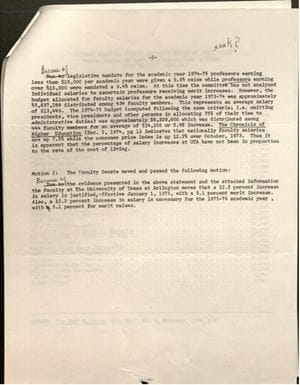Email: facultysenate@uta.edu
Origins
The Beginnings
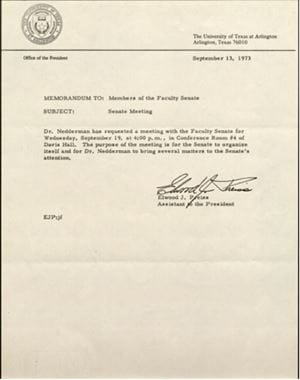
The Senate was convened for the first time on September 19th 1973 under the leadership of Charles McDowell and meeting in conference room number 4 of what is now known as the University Administration Building (Fig. 1). During its first meeting, officers were elected (Fig. 2).
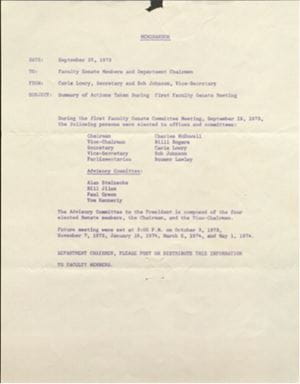
Over the first year, senators developed an operational philosophy, the By-Laws, the meeting framework, and the committee structure.
Although all of these changed slightly over the years, the basic structures of Senate have remained remarkably stable over the past fifty years. Agenda items, for example, have always had to be submitted in advance. In the early seventies, it was specified that they should be submitted to the Secretary a week ahead of the Senate meeting and preferably by writing and not in a phone call; now of course they are sent by email. The committee structure was established and remains much the same to the present, albeit with slight differences (Fig. 3).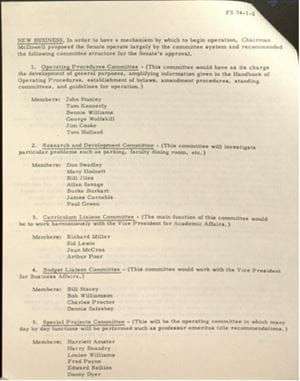

The purpose of Senate, from the beginning, was to work together on behalf of the faculty. As Charles McDowell noted, while thanking the first group of faculty senators, he hoped that “they could have a meaningful operation and experience by working with the administration and with all members of the faculty. He also expressed the hope that they could resolve some of their differences by compromise and believed the Senate would receive the support of the administration” (Fig. 5). 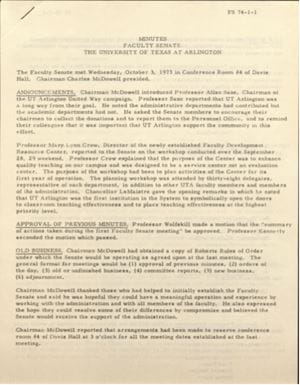
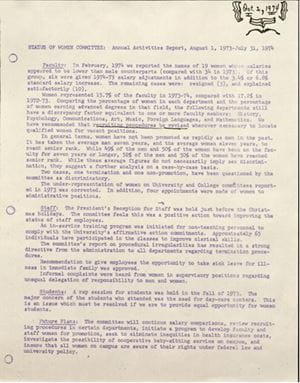
The first year of Senate a senator asked whether the Chair envisioned the Senate becoming the major faculty body and Charles McDowell stated that they did not have enough experience yet to determine this but that in theory it would.
The latter found that women were paid less than men--only 16% of faculty were women at this time--and promoted less frequently. A recommendation was made that a cooperative childcare center be founded on campus, a concern expressed also by students at this time.
In its second year of operation, 1974-75, Senate engaged with reports on faculty salaries and the status of women (Fig. 6).Senate sent a long memorandum on faculty salaries this year to the Chancellor, ending with a motion for a 12.2% increase with a 5.1% merit increase both of the following two years (Fig. 7 and Fig. 8).

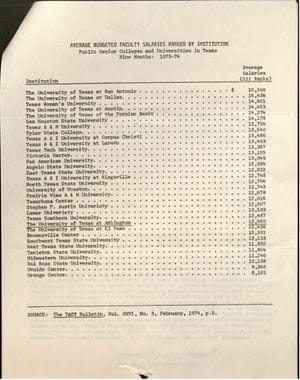
The average faculty salary at the time was $12460 (Fig. 9). Senate also discussed a critical shortage of M and O money and the problem of administrators returning to departments with inflated salaries.
In its third year of operation, Senate concurred that no smoking signs should be put up in classrooms, elevators, restrooms and the library. Smoking was banned at this time in Senate meetings. Also in 1976 Senate membership increased from 47 to 52 and the nursing program added Senate representatives for the first time.
Past Chair Achievements

Bill Carroll - Faculty Senate Chair 2019-2021
My two years as Senate Chair were dominated by university leadership changes and COVID, but my proudest achievement was steering the COACHE Faculty Job Satisfaction Survey to successful completion. – Bill Carroll, Faculty Senate Chair, 2019-2021

David Coursey- Faculty Senate Chair 2017 - 2019
Some of the achievements that I am most proud of include doubling faculty mandatory promotion raises, Senate inclusion of non-tenure track faculty, workload policy reform, implementation of shared governance in college and university budgeting, and creation of the Academy of Distinguished Service Leaders.

Dan Cavanagh - Faculty Senate Chair 2015-2017
One thing I am most proud of throughout my time as senate chair is the continued development of the inclusion of faculty voice in decision making at the university, most specifically in the budgeting process.

Antoinette (Toni) Sol - Faculty Senate Chair 2012 - 2015
I am proud that while I was Chair the ground work was laid for a new university faculty tenure and promotion committee to replace one consisting of three upper administrators, representing a significant event in shared governance at UTA. Also, I am proud of serving as an officer on the UT System Faculty Advisory Council, continuing a tradition of UTA faculty leadership at the system level.
